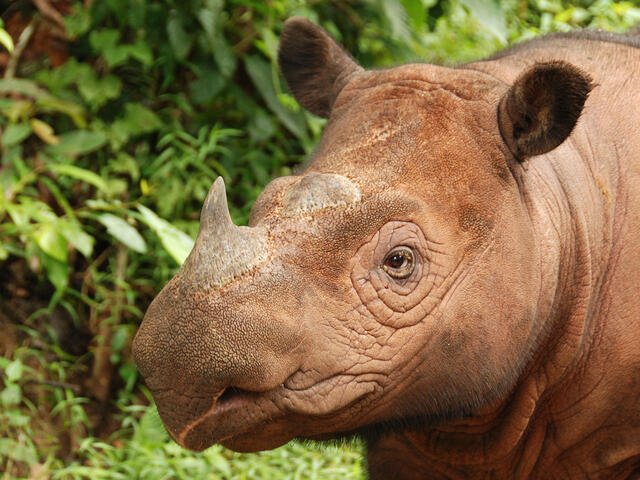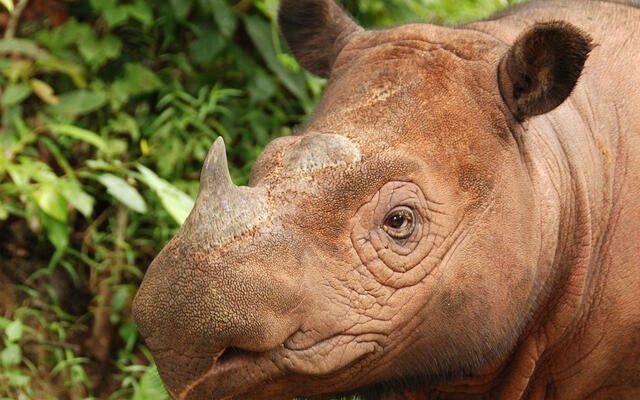
In this article, we’re diving into a list of 10 animals that are similar to the Sumatran rhinoceros. Our goal is to help you understand what makes each of them unique while highlighting their similarities. Whether it’s another type of rhino, a hefty herbivore, or an unexpected relative, you’ll see how the natural world is interconnected. So grab that coffee, and let’s explore!
1. Indian Rhinoceros
The Indian rhinoceros, also known as the one-horned rhino, is perhaps the closest relative to the Sumatran rhino. With its impressive size and thick, plated skin, this rhino stands out in the crowd. You might recognize it by its single horn, which can grow up to 10 inches long! While the Sumatran rhino has two horns and is much smaller, the Indian rhino shares its habitat preferences, often found in grasslands and wetlands.
Here’s the thing: despite their size difference, Indian rhinos are just as fascinating. Their skin folds resemble armor, which helps protect them from predators, much like a knight in shining steel. Both species are herbivorous, munching on grasses and shrubs, but the Indian rhino tends to prefer more open habitats compared to the dense forests favored by its Sumatran cousin.
2. Black Rhinoceros
Next up is the black rhinoceros, which, interestingly, isn’t black at all but rather a greyish color. These rhinos are a bit smaller than their Indian counterparts, and they have a more compact body. One way to tell them apart is by noting the shape of their mouths. The black rhino has a pointed upper lip, perfect for grasping twigs and leaves. In contrast, the Sumatran rhino’s lips are more rounded, designed for grazing.
Black rhinos are more solitary compared to the social Indian rhinoceros. They often enjoy a quiet life, nibbling away on bushes and shrubs. While they share some lifestyle habits with the Sumatran rhino, their habitats differ, as the black rhino thrives in a variety of environments, from savannas to scrublands.
3. White Rhinoceros
The white rhinoceros is the largest rhino species and can weigh up to 2,300 kilograms (around 5,000 pounds). Unlike the Sumatran rhino, which is much smaller and has a hairy appearance, the white rhino boasts a large, square-shaped mouth. This mouth structure is built for grazing, allowing it to munch on grass.
Despite their size, white rhinos are often seen in groups, making them more social. This contrasts the more solitary nature of the Sumatran rhino, which prefers its own company in the dense jungles of Southeast Asia. If you want to spot a white rhino, look for them in savannas and open grasslands, while the Sumatran rhino is tucked away in forested areas.
4. Javan Rhinoceros
The Javan rhinoceros is another close relative, often confused with the Sumatran rhino due to their similar size and skin texture. However, the Javan rhino has just one horn, which can make it slightly easier to distinguish. This species is also critically endangered, like the Sumatran rhino, with only about 74 individuals remaining in the wild.
You might wonder where to find these elusive animals. The Javan rhino mainly resides in Ujung Kulon National Park in Indonesia. While both Javan and Sumatran rhinos share a dense forest habitat, the Javan rhino prefers areas closer to water sources. They spend time wallowing in mud, a behavior shared with Sumatran rhinos, to keep their skin cool and protected from insects.
5. Tapirs
You might not think of a tapir when pondering rhinos, but these animals share some surprising similarities. Like rhinos, tapirs are large, herbivorous mammals with thick bodies and a similar environmental preference. They inhabit dense rainforests and are great swimmers, often submerging themselves in water to cool off.
Visually, tapirs have a more rounded body and a distinctive snout, which looks a bit like a short trunk. While they aren’t as closely related to rhinos as the previous examples, they share certain traits—both animals are gentle giants that graze on foliage. If you ever come across a tapir, they might remind you of a rhino, but with a cuter, more playful appearance.
6. Hippopotamus
The hippopotamus might seem like an odd choice, but it’s a relative of the rhinoceros! Both belong to the order Perissodactyla, which includes odd-toed ungulates. Hippos are significantly larger and spend most of their time in water. However, their herbivorous diet and large bodies make them somewhat comparable to the hefty Sumatran rhino.
One of the biggest differences is their environment. While the Sumatran rhino prefers lush forests, hippos are found in rivers and lakes across Africa. Their skin is hairless and smooth, unlike the more rugged appearance of rhinos. You might think of hippos as the party animals of the animal kingdom; they’re social and love to hang out in groups!
7. African Buffalo
The African buffalo is a sturdy animal often found in herds across the African savanna. While they are not closely related to rhinos, they share a similar body size and herbivorous diet. African buffaloes are known for their curved horns and massive build, making them look a bit like a mini rhino from a distance.
Despite similarities in diet, the buffalo is more social than the solitary Sumatran rhino. You often see them in large groups, foraging for grass. While their habitats vary, African buffalo prefer open woodlands, grasslands, and even swamps, demonstrating their adaptability.
8. Bison
Similar in size, the bison is another large herbivore that shares habitats with various grassland ecosystems. Bison are known for their massive heads and shaggy coats, resembling a moving fluffy couch in the wild. They feed primarily on grass and are often seen grazing in herds.
While they thrive in North America and are quite different from the Sumatran rhino’s rainforest habitat, their robust builds and diet create a common thread between these species. If you see a herd of bison lumbering across the plains, you might relate their presence to the solitary nature of the Sumatran rhino, which prefers to roam alone in its lush surroundings.
9. Gaur
The gaur, or Indian bison, is another massive herbivore that resides in the forests of Southeast Asia. With a powerful body and a large hump on its back, the gaur can easily be compared to the Sumatran rhino. However, while the Sumatran rhino is covered in thick skin and fur, the gaur has a smooth coat and prominent horns.
Gaur are generally more social, often roaming in herds. They prefer dense forests, similar to the Sumatran rhino’s habitat. Both species require substantial food intake to sustain their size, providing a unique connection to the plant life around them.
10. Wild Boar
Last but not least, the wild boar might seem like a stretch, but hear me out! While they’re much smaller than the Sumatran rhino, wild boars are also part of the same ecosystem and share some dietary habits. They dig for roots, tubers, and the occasional fruit, much like the smaller Sumatran rhino, which browses through the dense undergrowth.
Moreover, both wild boars and Sumatran rhinoceroses share a love for muddy areas, which help keep their skin healthy and free from pests. The difference, of course, lies in their size and social structure—while wild boars tend to roam in family groups, Sumatran rhinos lead a more solitary lifestyle.
—
In conclusion, the animal kingdom is full of fascinating creatures, and while they may share similarities with the Sumatran rhinoceros, each species highlights the diversity of life on our planet. The connections between these animals remind us of the intricate web of life, where even seemingly different species can share traits and adaptations. So, whether you’re drawn to the fierce black rhino or the gentle tapir, there’s a lot to appreciate about our wild neighbors—even the lesser-known ones like the Sumatran rhino. Let’s continue to explore and protect these unique creatures and their habitats for generations to come!

